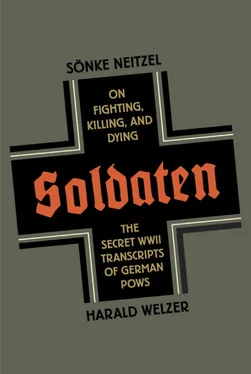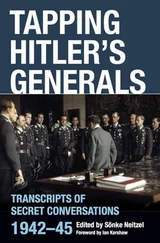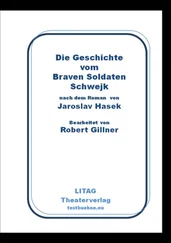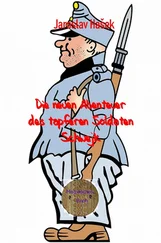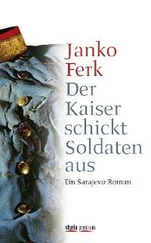Massive numbers, some 2.3 million, of Iron Crosses Second Class, were handed out, but more than 85 percent of members of the Wehrmacht did not receive even the lowest commendation for bravery. Their uniforms remained bare, while the military biographies of seasoned frontline fighters were on display for all the world to see. That brought social prestige and created intentional social pressure. German men knew that they could only prove themselves at the front. As a result, soldiers on home leave often illicitly donned medals to impress their friends and families and to avoid looking like shirkers. {78} 78 For more information on cases that led to convictions, see Rass, “Menschenmaterial,” pp. 256–58.
Nonetheless, by rewarding the most dangerous wartime deployments, accolades played an important practical role as an incentive in the Third Reich.
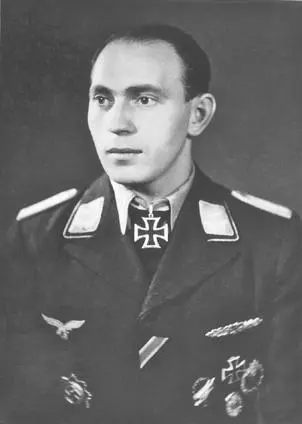
First Lieutenant Alfons Bialetzki wearing the Iron Cross First and Second Class, the Gold Medal for War Wounded, the Parachutist and Infantry Assault Badge, the Gold Close-Combat Clasp, the German Cross (Gold Class), and the Knight’s Cross. On his upper right arm he wears two individual antitank identifications and a Crete armband. (From Florian Berger, Ritterkreuzträger mit Nahkampfspange in Gold , Vienna, 2004)
The Wehrmacht was careful to protect the prestige of their accolades by clearly defining when they should be awarded and introducing rules to ensure that they reflected true achievement and service. With the massive number of Iron Crosses handed out, it was hardly possible to prevent abuse, yet the transparency of the accolade system during World War II still made it much more widely accepted than the system in place in World War I. The Wehrmacht also did its best to commend soldiers as quickly as possible. Dönitz was not averse to awarding Knight’s Crosses over the radio if a submarine captain reported achieving a particularly significant victory. Nazi propaganda constantly featured the bearers of awards for extraordinary bravery, and Goebbels made a handful of them into full-fledged media stars. {79} 79 René Schilling, “Kriegshelden”: Deutungsmuster heroischer Männlichkeit in Deutschland, 1813–1945 (Paderborn: Schoeningh Verlag 2002), pp. 316–72.
Significantly, in designing such medals, the military downplayed the swastika symbol. The exception was the German Cross (Gold Class), which led conservatives, in the words of one commentary, “to feel less than enthusiastic… about the presumptuous National Socialist emblem.” {80} 80 Hartmann, Wehrmacht im Ostkrieg, p. 198.
The symbolism of and policies with which awards were bestowed were designed to create a sense of social acknowledgment, and this anchored military values deep within soldiers’ frames of reference. As we will see, the normative models that resulted influenced how German men perceived the world and, in the majority of cases, how they acted as well. But those models didn’t necessarily transfer to Nazi ideology; indeed, emphasis on ideology seems to have engendered resistance. As historian Ralph Winkle determined in conjunction with World War I, only in a minority of cases did individual pride at receiving an accolade lead to an acceptance of the political leadership’s concurrent and comprehensive expectations concerning individual behavior. {81} 81 See Ralph Winkle, Der Dank des Vaterlandes: Eine Symbolgeschichte des Eisernen Kreuzes, 1914 bis 1936 (Essen: Klartext, 2007), p. 345ff.
Against the backdrop of a social culture of categorical inequality and a Wehrmacht culture emphasizing the military values of hardness and bravery, we can reconstruct the contours of the typical soldier’s frame of reference as he went to war. Significantly, the central values of this orientation remained stable throughout the war, even as soldiers’ appraisals of the military leadership and the National Socialist system changed markedly. The military reference frame also obtained across individual differences of politics, “philosophy,” and character. In terms of their high estimation of the military values just sketched out, out-and-out National Socialists did not differ from committed anti-Nazis, which is why the two groups didn’t behave differently during the war itself. The main differences, as we will discuss later, occurred chiefly between Wehrmacht soldiers and the Waffen SS.
Fighting, Killing, and Dying
“Throwing bombs has become a passion with me. One itches for it; it is a lovely feeling. It is as lovely as shooting someone down.”
A Luftwaffe first lieutenant, July 17, 1940
{82} 82 SRA 177, 17 July 1940, TNA, WO 208/4118.
They say that war brutalizes, that soldiers are turned into beasts by the experience of violence, by being confronted with mutilated bodies and dead comrades or, in the case of a campaign of annihilation, with masses of murdered men, women, and children. Even the Wehrmacht and the SS were concerned that constant exposure to extreme violence, be it as witnesses or perpetrators, would damage soldiers’ “manly discipline” and lead them to engage in unconstrained, unregulated brutality—at the cost of the efficiency needed for both World War II and mass exterminations. {83} 83 This became especially clear in the discussions surrounding the ordinances. Felix Römer, “Im alten Deutschland wäre ein solcher Befehl nicht möglich gewesen: Rezeption, Adaption und Umsetzung des Kriegsgerichtsbarkeitserlasses im Ostheer, 1941/42,” VfZG 56 (2008), pp. 53–99.
The idea of war brutalizing soldiers plays a central role in social-psychological research on violence. {84} 84 James Waller, Becoming Evil: How Ordinary People Commit Genocide and Mass Killing (Oxford: Oxford University Press, 2002).
Scholars assume that extremely violent experiences change the way people evaluate their worlds and make them more prone to violent acts of their own. Autobiographies and war fiction reinforce the impression that over time, soldiers become brutal as they themselves are exposed to increasing brutality.
But the words of the Luftwaffe first lieutenant cited above suggest that this notion may be misleading. The brutalization hypothesis excludes the possibility that violent behavior can be something attractive for which one “itches,” and it presumes, with no real proof, that people need to be somehow pre-trained to commit acts of extreme violence. Perhaps all that is needed is a weapon or an airplane, some adrenaline, the feeling of having power in areas where one normally has none, and a social framework in which killing is permissible, even desirable.
The hypothesis of successive adjustment to and acceptance of violence may have more to do with self-images that historical actors would like to maintain and the preconceived ideas of researchers than with the realities of war. The surveillance protocols contain an abundance of material suggesting that soldiers were extremely prone to violence right from the start of World War II. The quote introducing this chapter, for instance, was recorded early on in the war, at a point when the conflict had not become an all-or-nothing struggle for survival. Moreover, the first lieutenant in question had only experienced war from above, from the air. Thus, while many soldiers may recount a process of brutalization when they recall violent events, by their own admission the time in which they are socialized to accept extreme violence often spans no more than a few days.
Let us take the example of a conversation between Lieutenant Meyer*, [2] Asterisks indicate a pseudonym for a POW not explicitly named in the surveillance protocols.
a Luftwaffe pilot, and Lieutenant Pohl, a Luftwaffe observer, from April 30, 1940:
Читать дальше
